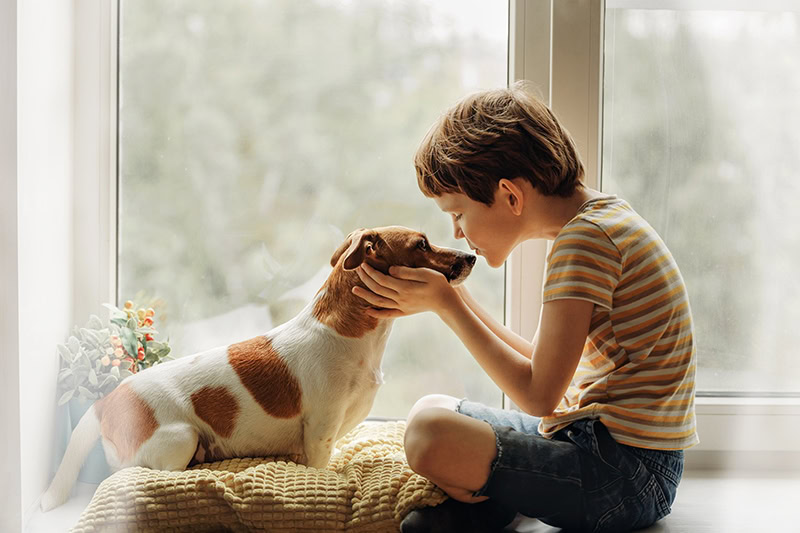VET APPROVED

The information is current and up-to-date in accordance with the latest veterinarian research.
Learn more »Click to Skip Ahead
Rehoming a dog can be an emotionally charged experience filled with guilt and sadness but also hope for a better future for your furry friend. However, ensuring that your pet finds a safe, loving, and suitable new home requires careful planning and attention to detail.
In this article, we will walk you through five essential steps to responsibly rehome a dog, ensuring they have a smooth transition to their new forever home.

The 5 Important Steps for Rehoming a Dog
1. Obtain Veterinary References
The first step involves assessing the potential adopter’s history of pet ownership, and a great way to do this is by obtaining references from their vet. It might seem a tad intrusive, but it’s a recommended step to ensure the safety and well-being of your dog.
A vet can provide insights into whether the potential adopter’s previous pets received regular health check-ups and care and if they acted responsibly during medical emergencies. If a prospective owner hesitates to provide a vet reference, consider this a red flag.

2. Arrange a Home Visit
Imagine moving into a house you’ve never seen before. It would be a bit unsettling, right? It’s the same for your pet. Therefore, the second crucial step in the rehoming process is to personally visit the potential new home.
This step allows you to assess the living conditions and ensure they are suitable for your pet’s needs. A clean, safe environment equipped with the necessary facilities, and showing signs of pet-friendly planning, should be the ideal scenario. Rejecting a potentially unsafe or unsanitary home is in the best interest of your pet.
3. Implement a Trial Period
When it comes to rehoming, surprises are unwelcome. Step three involves arranging a trial weekend or period to avoid any unexpected turns of events. A trial period allows both your pet and the potential new family to adjust to each other.
This short duration can help reveal any unforeseen issues, such as aggression from other pets, incompatibility, or unexpected allergies. Additionally, it can provide insights into how well your pet fits into the prospective family’s lifestyle and routine.
4. Discuss Future Involvement
The fourth step is a conversation about your involvement in your pet’s future. When rehoming, you relinquish rights over your pet, but that doesn’t necessarily mean you can’t be a part of their life. This conversation could cover agreements about future visits, updates about the pet, and shared responsibilities, if any.
However, remember to be respectful of the new owners’ boundaries. This step is crucial in setting clear expectations, thereby avoiding misunderstandings and ensuring a smooth transition for your pet.

5. Establish a Rehoming Fee
Lastly, a rehoming fee is an important yet often overlooked aspect. While it might feel uncomfortable to ask for money, a rehoming fee can play a significant role in determining the prospective adopter’s commitment level.
Items of value are generally better cared for, and a rehoming fee helps ensure that the new owners understand the worth of the responsibility they’re taking on.

How Long Does It Take for a Dog to Adjust to a New Home?
Adjusting to a new home is a process, both for humans and our furry friends. Much like us, dogs too need time to get used to new surroundings, routines, and family members.
The transition period varies for each pet depending on factors such as their age, past experiences, temperament, and the environment in the new home. However, we can often see some general patterns.
Around three weeks is often the first significant milestone. By this point, many dogs have started to settle down and may behave as if they’ve accepted their new home. But this doesn’t necessarily mean they’ve fully adjusted.
On the contrary, they might still be figuring out their boundaries, understanding their new family members, and adapting to the new routines and rules. It’s also possible that they might show a few behavioral issues at this stage as they navigate this new chapter of their life.
As time goes on, the three-month mark is the next significant milestone. By this time, your rehomed dog has likely adjusted to the routines and rhythms of their new home. They’ve probably developed a bond with their new family and feel comfortable and secure in their surroundings.
However, these are rough estimates, and every dog is unique. Some might breeze through the transition, while others may take longer to feel at home. It’s essential to be patient, understanding, and persistent during this period.
Make them feel loved, provide them with a stable routine, and allow them to adjust at their own pace. It may take time, but witnessing your rehomed dog finally feel at home is undoubtedly worth the wait.

Is Rehoming Stressful for Dogs?
It’s essential to understand that rehoming can indeed be a stressful experience for dogs. They form deep bonds with their human companions and become accustomed to specific routines, environments, sounds, and smells.
Consequently, being uprooted from a familiar environment and moved to a new one can lead to a range of emotions, including confusion, anxiety, and fear. Spending time in a rescue or being rehomed, especially multiple times, can increase the risk of developing separation anxiety.
Separation anxiety isn’t just a human condition—dogs can also exhibit grief and behavioral problems when they’re apart from their human companions. Rehoming can exacerbate this condition as the dog has to deal with the loss of their previous human family and adapt to a new one, often causing significant emotional upheaval.
However, it’s important to remember that, in some cases, rehoming may be the only viable option for the dog’s well-being. This could be due to a variety of reasons, including changes in the owner’s life circumstances, an unfit living environment, or an inability to provide adequate care.
The Role of Shelters
When rehoming is necessary, shelters and rescue organizations play a critical role. They are well-equipped to handle cases of separation anxiety and other behavioral issues. They will do their best to find an adopter or a foster home that understands the dog’s situation and is prepared to address their emotional needs with patience, care, and understanding.
Rehoming a dog is a complex process requiring empathy, patience, and dedication. It’s a responsibility that should not be taken lightly, but with the right approach, it can lead to a much happier and healthier life for the dog in question.

Conclusion
Rehoming a dog is never an easy decision, and the process can be daunting. However, taking these five steps can help ensure that your pet finds a loving, safe, and suitable new home.
While you may lose the daily cuddles, walks, and playful moments, knowing your dog is happy and well-cared for can offer immense comfort. Always remember, rehoming is an act of love, a difficult decision made in the best interest of your pet. As such, taking every step carefully and responsibly can make a world of difference in your pet’s life.
Featured Image Credit: Yuliya Evstratenko, Shutterstock











